You can Download Chapter 17 Breathing and Exchange of Gases Questions and Answers, 1st PUC Biology Question Bank with Answers, Karnataka State Board Solutions help you to revise complete Syllabus and score more marks in your examinations.
Karnataka 1st PUC Biology Question Bank Chapter 17 Breathing and Exchange of Gases
1st PUC Biology Breathing and Exchange of Gases NCERT Text Book Questions and Answers
Question 1.
Define vital capacity. What is its significance?
Answer:
Vital capacity is the maximum volume of air a person can breathe in after a forced expiration. It is the sum of Inspiratory reserve volume (IRV), Expiratory reserve volume (ERV) and the Tidal volume (TV).
The vital capacity is different for different person. Its higher in athletes than in non-athletes, in mountain dwellers than in people living on plains and in youth than in old age. Cigarette smoking reduces the vital capacity.
Question 2.
State the volume of air remaining in the lungs after a normal breathing.
Answer:
Functional Residual capacity.
Question 3.
Diffusion of gases occurs in the alveolar region only and not in the other parts of respiratory system. Why?
Answer:
Only alveolar region is made up of squamous epithelium which is favorable for diffusion of gases.
![]()
Question 4.
What are the major transport mechanisms for CO2? Explain.
Answer:
CO2 is carried by haemoglobin as carbamino haemoglobin. This binding is related to the partial pressure of CO2. When PO2 is low as in the tissues and PCO2 is high, more carbon dioxide binding occurs whereas when PCO2 is low and PO2 is high as in the alveoli, dissociation of CO2from carbamino haemoglobin takes place. RBC contains a high concentration of enzyme carbonic anhydrase that converts carbon dioxide to bicarbonates and vice versa.

CO2 diffuses the blood and forms bicarbonate ions. Thus CO2 is trapped as bicarbonate at the tissue level and transported to the alveoli and released out as CO2. A small amount of CO2 dissolves in the plasma water and forms acid. On reaching the lungs carbonic acid dissociates and releases carbon dioxide. So carbon dioxide is transported as carbamino-haemoglobin, bicarbonates and carbonic acid.
Question 5.
What will be the PO2 and PCO2 In the atmospheric air compared to those in the alveolar air?
(i) PO2 lesser, PCO2 higher
(ii) PO2 higher, PCO2 lesser
(iii) PO2 higher, PCO2 higher
(iv)PO2 lesser, PCO2 lesser
Answer:
(ii) PO2 higher, PCO2 lesser
Question 6.
Explain the process of inspiration under normal conditions.
Answer:
The intake of air into the lungs is known as inspiration. Inspiration occurs when the pressure within the lungs is less than the atmospheric pressure. It is initiated by the contraction of diaphragm which increases the volume of thoracic chamber in the anteroposterior axis. The contraction of external intercostal muscles lifts up the ribs and the sternum causing an increase in the volume of the thoracic chamber in the dorsoventral axis. The overall increase in the thoracic volume causes a similar increase in pulmonary volume which decreases the intra-pulmonary pressure to less than the atmospheric pressure which forces the air from outside to move into the lungs.
Question 7.
How is respiration regulated?
Answer:
A specialised centre present in the medulla region of the brain called respiratory rhythm centre is primarily responsible for the regulation of respiration. Another centre present in the pons region of the brain called pneumotaxic centre can reduce the duration of inspiration and thereby alter the respiratory rate.
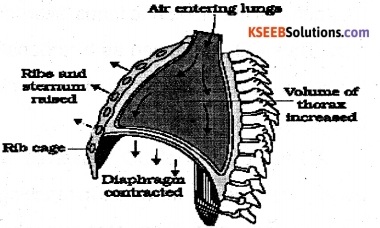
A chemosensitive area situated adjacent to the rhythm centre is highly sensitive to CO2 and hydrogen ions. Increase in these substances can activate this centre, which in turn can signal the rhythm centre to make necessary adjustments in the respiratory process. Receptors associated with aortic arch and carotid artery also can recognise changes in CO2 and H+ concentration and send necessary signals to the rhythm centre for remedial actions.
Question 8.
What is the effect of PCO2 on oxygen transport?
Answer:
Partial pressure of CO2, hydrogen ion concentration and temperature are the factors that regulates binding of O2 with haemoglobin to form oxyhaemogiobin. In the alveoli, there is high PO2 low PCO2, lesser H+ concentration and lower temperature that favours the formation of oxyhaemogiobin. In the tissues, there is low PO2, high PCO2, high H+ concentration and higher temperature that favour the dissociation of oxygen from the oxyhaemogiobin.
Question 9.
What happens to the respiratory process in a man going up a hill?
Answer:
There is a fall of PO2 level at high altitudes. This lowers alveolar PO2 and consequently reduces the diffusion of oxygen from the alveolar air to the blood. So oxygenation of blood is decreased progressively.
After some time, the affected person gets adjusted to the surroundings due to which the heart rate are accelerated, RBC count in the blood is increased, haemoglobin level and oxygen-carrying capacity are also increased.
![]()
Question 10.
What is the site of gaseous exchange in an insect?
Answer:
Insects have a network of tubes (tracheal tubes) to transport air within the body. Air enters the spiracles during inspiration and reaches the tracheoles which contain tissue fluids. Oxygen in the air dissolves in those fluids and reaches the cells.
Question 11.
Define oxygen dissociation curve. Can you suggest any reason for its sigmoidal pattern?
Answer:
The curve in which percentage saturation of haemoglobin with O2 is plotted against the partial pressure of oxygen (PO2) is called the oxygen dissociation curve. At a PO2 of 100 mm Hg, 100 percent saturation of Hb takes place 90% saturation of Hb takes place even at a P02 of 60mm Hg. An I fall of PCX, from 100 to 60mm Hg will cause only 10% decrease in saturation of Hb. Hence the curve takes the shape of a sigmoid.
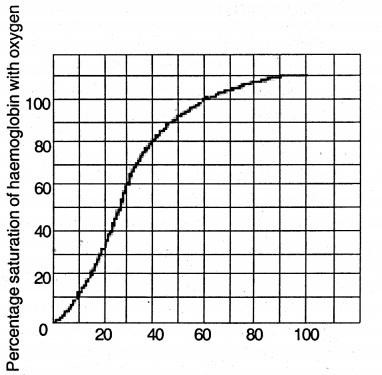
Question 12.
Have you heard about hypoxia? Try to gather information about it, and discuss with your friends.
Answer:
Hypoxia is the condition in which there is a deficiency of oxygen at the tissue level.
- Arterial hypoxia: It’s because of low level of oxygen in the blood. It occurs when the atmosphere does not contain enough oxygen and there is obstruction in the respiratory passage.
- Anaemic hypoxia: It is due to very low level of haemoglobin in the blood.
- Stagnant hypoxia: It is due to the inadequate blood flow to deliver oxygen to the tissue.
- Histoxic hypoxia: It is due to the presence of toxic substances in the oxygen inhaled, e.g.: Cyanide poisoning.
Question 13.
Distinguish between
(a) IRV and ERV
(b) Inspiratory capacity and Expiratory capacity.
(c) Vital capacity and Total lung capacity.
Answer:
(a) Inspiratory Reserve volume (IRV) is an additional volume of air a person can inspire by a forcible inspiration. It averages 2500 ml to 3000 ml. Expiratory Reserve volume (ERV) is an additional volume of air that a person can expire by a forcible expiration. This averages 1000 ml to 1100 ml.
(b) Inspiratory capacity (IC) is the total volume of air a person can inspire after a normal expiration. It is the sum of tidal volume and inspiratory reserve volume.
Expiratory capacity (EC) is the total volume of air a person can expire after a normal inspiration. It is the sum of tidal volume and expiratory reserve volume.
(c) Vital capacity is the maximum volume of air a person can breathe in after a forced expiration. It is the sum of Tidal volume, expiratory reserve volume and inspiratory reserve volume. It is also the maximum volume of air a person can breathe out after a forced inspiration.
![]()
Total lung capacity is the total volume of air accommodated in the lungs at the end of a forced inspiration. It is the sum of Residual volume, expiratory reserve volume, tidal volume and the inspiratory reserve volume.
Question 14.
What Is Tidal volume? Find out the Tidal volume (approximate value) for a healthy human in an hour.
Answer:
Tidal volume is the volume of air inspired or expired during a normal respiration. It is approximately 500 ML. A healthy man can inspire or expire approximately 360 L to 480 L of air every hour.
1st PUC Biology Breathing and Exchange of Gases Additional Questions and Answers
1st PUC Biology Breathing and Exchange of Gases One Mark Questions
Question 1.
What is an expiration?
Answer:
Movement or exit of air from the alveoli of the lungs to outer atmosphere is called expiration or exhalation.
Question 2.
What is Ventilation? OR What Is breathing?
Answer:
It is a process by which air is exchanged between the atmosphere and the alveoli of lungs or Entry of atmospheric air into the alveoli of lungs and exit of air from the alveoli into the atmosphere is called pulmonary ventilation or breathing.
Question 3.
What is inhalation or inspiration?
Answer:
Entry of air into alveoli of the lungs is called inspiration or inhalation.
Question 4.
Which muscles do you find In diaphragm?
Answer:
Skeletal muscles.
Question 5.
Which process helps in increasing the size of the thorax during respiration? (Oct. 1990, April 1995)
Answer:
The contraction of the external inter-costal muscles of the ribs and the muscles of the diaphragm.
Question 6.
Name the membrane (covering) of the lungs. (April 91, 93, 94)
Answer:
Pleural membrane (Pleuron). [The plural membrane (outer Fibrous & inner serous)]
Question 7.
What art; the functional units of lungs called? (Oct. 92, 99, July 2010)
Answer:
The Alveoli.
Question 8.
Mention the respiratory pigment.
Answer:
Haemoglobin. (April 98)
Question 9.
What is Spirometer? (April 2002)
Answer:
The apparatus used in measuring the amount of air exchanged during breathing & the rate of ventilation is the Spirometer.
![]()
Question 10.
Name the last part of the bronchiole tree.
Answer:
Alveoli. (April 2003)
Question 11.
Which is a common passage for both air and food in man ? (July 2006)
Answer:
Trachea
Question 12.
Name the enzyme that acts on carbonic acid in living cells. (Delhi 2006)
Answer:
Carbonic Anhydrase.
Question 13.
Where is carbonic anhydrase found in human body? Give its function.
Answer:
Carbonic anhydrase is found in RBC. It catalyses the formation of carbonic acid from carbon dioxide and water.
Question 14.
What are the two factors that contribute to the dissociation of oxyhemoglobin in the arterial blood to release molecular oxygen in an active tissue? (Delhi 2000)
Answer:
Low PO2, high PCO2, high H+ concentration and high temperature.
Question 15.
Name the respiratory organs of
(1) butterfly and
(2) frog larva. (All India 1996)
Answer:
- Trachea
- Gills.
Question 16.
What is a soundbox?
Answer:
Larynx is a cartilaginous box which helps in sound production and hence called the sound box.
Question 17.
What are alveoli?
Answer:
Alveoli are number of very thin, irregular walled and vascularised bag like structures into which terminal bronchioles end.
Question 18.
How does diaphragm help in inspiration? (All India 998 C)
Answer:
When the diaphragm muscles contract, it moves down towards abdomen, increasing the volume of thoracic cavity, but decrease in air pressure. So air is drawn into the lungs.
Question 19.
What is the maximum number of molecules of oxygen which one molecule of haemoglobin can carry? (All India 1998 C)
Answer:
Four.
![]()
Question 20.
What is formed when CO2 combines with globin part of reduced haemoglobin? Where does it occur? (All India 1998 C)
Answer:
Carbamino haemoglobin.
Its formation occurs in metabolicaily active tissues.
Question 21.
Which part (s) of the brain control (breathing movements? (Foreign 1997)
Answer:
Medulla and pons.
Question 22.
Name two animals where exchange of gases occurs by diffusion across their entire body surface.
Answer:
Hydra, Sponges, flatworms etc.,
Question 23.
What is the function of pleural fluid?
Answer:
Pleural fluid reduces the friction on the lung surface.
Question 24.
State the function of exchange part.
Answer:
Exchange part is the actual site of diffusion of oxygen and carbon dioxide between blood and atmosphere.
Question 25.
What causes the movement of air in and out of lungs?
Answer:
Pressure gradient between the lungs and the atmosphere.
Question 26.
Name the structures that bring about a pressure gradient between lungs and the atmosphere.
Answer:
Diaphragm and intercostal muscles.
Question 27.
Why does exchange of respiratory gases continue to occur in the lungs even after a maximum expiration?
Answer:
Some amount of air, called residual vol-ume, remains in the lungs even after forceful expiration.
Question 28.
Name the primary site of respiratory gas exchange.
Answer:
Alveoli.
Question 29.
Define partial pressure of a gas?
Answer:
The pressure exerted by an individual gas in a mixture of gases is called partial pressure.
Question 30.
Why can more CO2 diffuse across the respiratory membrane per unit difference in the pressure as compared to oxygen?
Answer:
Tne solubility of CO2 is 20-25 times higher than that of O2. So more CO2 diffuses across the respiratory membrane.
Question 31.
What is oxyhaemoglobln?
Answer:
Oxyhaemoglobin is a complex formed when oxygen combines with the Fe2+ part of haemoglobin.
Question 32.
How much of CO2 is transported by 100 ml of blood
Answer:
About 4 ml.
Question 33.
What is carbamino haemoglobin?
Answer:
Carbamino haemoglobin is the complex formed when carbon dioxide combines with the amine radical of the globin of haemoglobin.
![]()
Question 34.
Where is the respiratory rhythm centre located?
Answer:
Medulla.
Question 35.
How does pneumotaxic centre alter the respiratory rate.
Answer:
Pneumotaxic centre can reduce the duration of inspiration and alter the respiratory rate.
Question 36.
Where are the receptors that can sense the changes in CO2 and H+ concentration located?
Answer:
Receptors are located in the aortic arch and carotid artery.
1st PUC Biology Breathing and Exchange of Gases Two Marks Questions
Question 1.
What is inspiration and expiration.
Answer:
- Inspiration: Entry of air into alveoli of the lungs is called inspiration or inhalation.
- Expiration: Movement or exit of air from the alveoli of the lungs to outer atmosphere is called expiration or exhalation.
Question 2.
Mention the functions of trachea.
Answer:
- It is called wind pipe helps for passage of air.
- Cilia move upwards towards the larynx, and this movement keeps out inhaled particles of dust, pollen etc.
- The cartilages which serve to keep the trachea open makes easy passage of air.
Question 3.
Write any two functions of larynx.
Answer:
- Larynx is called voice box. The vibration of vocal cords produce sound.
- It helps in speech.
- It prevents the entry of food into the lungs.
The epiglottis present in larynx helps to close off the larynx during swallowing.
Question 4.
Mention any four conducting parts of the human respiratory system. (April 83, 92, 99)
Answer:
- Nasal cavities
- Nasopharynx
- Trachea
- Bronchial tree.
Question 5.
Draw a neat labelled diagram of alveolus.
Answer:
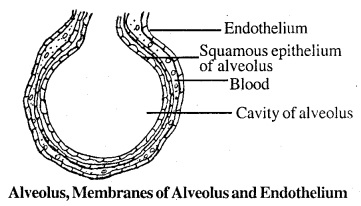
Question 6.
Write a note on pleura.
Answer:
The two lungs are covered by a double layered membrane called pleura, with pleural fluid between them. The fluid reduces the friction on the lung surface. The outer pleural membrane is in close contact with the thoracic lining whereas the inner pleural membrane is in contact with the lung surface.
Question 7.
Mention four functions of the conducting part of the human respiratory system.
Answer:
- It transports the air into alveoli
- It clears the air from foreign particles.
- It moistens and humidifies the air.
- It brings the air to body temperature.
Question 8.
Mention the boundaries of the thoracic cavity. What is the use of them?
Answer:
The thoracic cavity is formed dorsally by the vertebral column, ventrally by the sternum, laterally by the ribs and on the lower side by the dome:shaped diaphragm. The anatomical setup of lungs in thorax is such that any change in the volume of the thoracic cavity will be reflected in the lung (pulmonary) cavity, which is essential for breathing as we cannot directly alter the pulmonary volume.
Question 9.
How do partial pressures of respiratory gases determine the diffusion of oxygen from the blood capillaries into the tissues?
Answer:
In the tissues, PCO2 is high, PO2 is low and there is high concentration of H+ ions and high temperature. Since the PO2 is lower than that of the blood, oxyhaemoglobin dissociates and releases the oxygen into the tissues.
Question 10.
How are gases transported in human body?
Answer:
Blood is the medium of transport for O2 and CO2. About 97% of O2 is transported by RBCs in the blood. The remaining 3% of O2 is carried in a dissolved state through the plasma. Nearly 20-25 percent of CO2 is transported by RBCs whereas 70% of it is carried as bicarbonate. About 7% is carried in a dissolved state through plasma.
Question 11.
Name the factors that affect the binding of oxygen to haemoglobin.
Answer:
The factors are:-
- Partial pressure of oxygen
- Partial pressure of carbon dioxide
- Hydrogen ion (H+ ) concentration
- Temperature.
![]()
Question 12.
What is carbonic anhydrase? List the three major forms In which the carbon dioxide is transported in the blood?
Answer:
Carbonic anhydrase is an enzyme that is present in RBC which catalyses the formation of carbonic acid from carbon dioxide and water. CO2 is transported
- In the dissolved form in the plasma
- As bicarbonates in the plasma and RBC
- As carbamino haemoglobin.
Question 13.
Give the values PO2 and PCO2 respectively of each of the following
(1) Atmospheric air
(2) Tissues of the body
Answer:
- Atmospheric air PO2= 159 mm Hg; PCO2 = 0.3 mm Hg;
- Tissues of the body PO2= 40 mm Hg; PCO2 = 40 mm Hg;
Question 14.
What is emphysema? What is its major cause?
Answer:
Emphysema is a chromic disorder in which alveolar walls are damaged due to which respiratory surface is decreased. One of the major causes of this is cigarette smoking.
Question 15.
Where is pneumotaxic centre located in humans? What is its significance inbreathing?
Answer:
Pneumotaxic centre is located in the pons region of the brain.
Neural signal from this centre can reduce the duration of inspiration and thereby alter the respiratory rate.
Question 16.
Name the three layers of diffusion membrane.
Answer:
- Squamous epithelium of alveoli
- Endothelium of alveolar capillaries
- Basement substance.
1st PUC Biology Breathing and Exchange of Gases Three Marks Questions
Question 1.
Explain the transport mechanism of oxygen.
Answer:
Oxygen binds with haemoglobin in reversible manner to form oxyhaemoglobin. About 97% of O2 is transported as oxyhaemoglobin. Each haemoglobin molecule can carry a maximum of four molecules of O2. Binding of O2 with haemoglobin depends on partial pressure of oxygen primarily and also on partial pressure of carbon dioxide, hydrogen ion concentration and temperature.
In the alveoli, where there is high pO2, low pCO2, lesser H+ concentration and lower temperature, the factors are all favourable for the formation of oxyhaemoglobin, whereas in the tissues, where low PO2, high PCO2, high H+ concentration and higher temperature exist the conditions are favourable for dissociation of oxygen from the oxyhemoglobin. This indicates that O2 gets bound to haemoglobin in the lung surface and gets dissociated at the tissues.
Question 2.
Describe the role of haemoglobin in the transport of respiratory gases. (Foreign 2001)
Answer:
- Oxygen binds to the Fe2+ part of haemoglobin and is transported as oxyhaemoglobin through the RBCs of the blood.
- Each molecule of haemoglobin can transport a maximum of four oxygen molecules.
- CO2 combines with the amine radial of haemoglobin to form carbamino haemoglobin and about 20 – 25% of CO2 is transported in this form.
Question 3.
Draw a neat labelled diagram of human respiratory system showing the mechanism of
(a) inspiration
(b) expiration.
Answer:
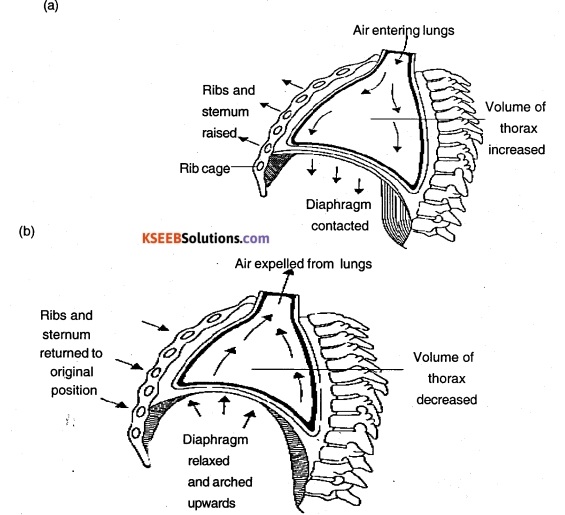
Question 4.
Explain the process of expiration under normal conditions.
Answer:
Expiration takes place when the intra-pulmonary pressure is higher than the atmospheric pressure. The diaphragm and a specialised set of muscles-external and internal intercostals between the ribs, help in generation of such gradients.
Relaxation of the diaphragm and the intercostal muscles returns the diaphragm and sternum to their normal positions after inspiration which reduces the thoracic volume and thereby the pulmonary volume. This leads to an increase in intra-pulmonary pressure to slightly above the atmospheric pressure causing the expulsion of air from the lungs, i.e. expiration.
![]()
Question 5.
Give a diagrammatic representation of exchange of gases at the alveolus and the body tissues with blood and transport of oxygen and carbon dioxide.
Answer:
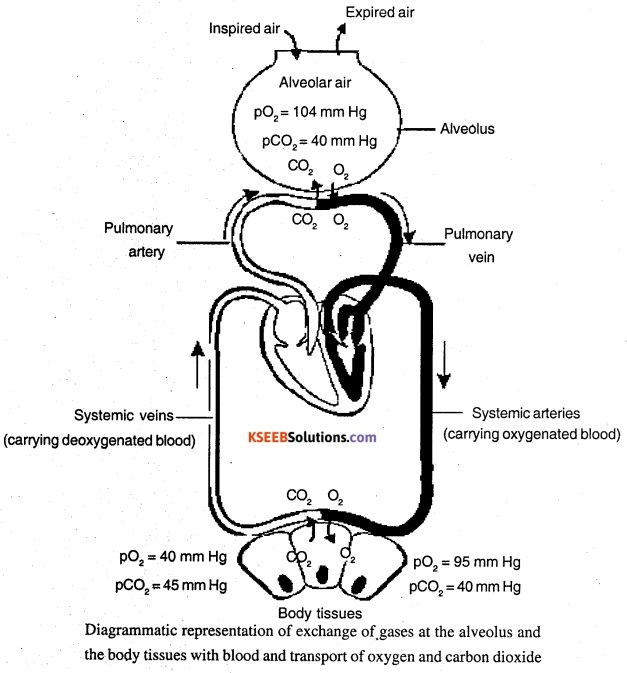
Question 6.
Draw a labelled diagram of a section of an alveolus with pulmonary capillary.
Answer:
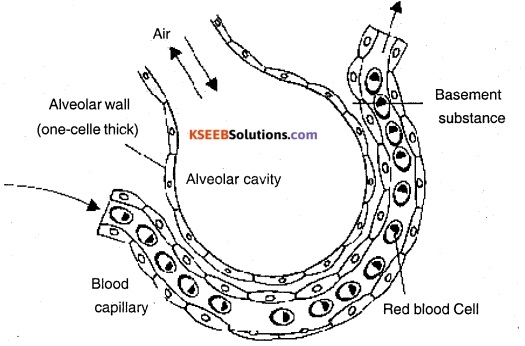
Question 7.
Name and explain few disorders of respiratory system.
Answer:
- Asthma: It is a difficulty in breathing causing wheezing due to inflammation of bronchi and bronchioles.
- Emphysema: It is a chronic disorder in which alveolar walls are damaged due to which respiratory surface is decreased. This is mainly caused by cigarette smoking.
- Occupational Respiratory disorders: In certain industries, involving grinding and stone breaking the dust produced results in inflammation leading to fibrosis and this causing serious lung damage.
1st PUC Biology Breathing and Exchange of Gases Five Marks Questions
Question 1.
Draw a neat labelled diagram of human respiratory system.
Answer:
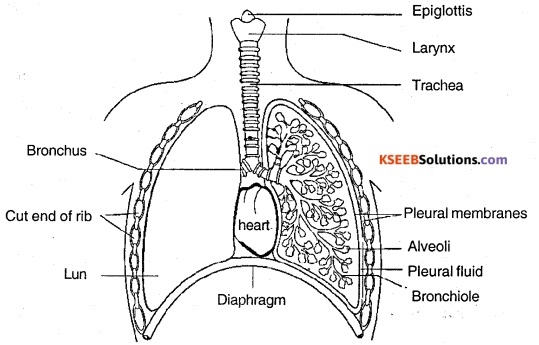
Question 2.
Give the five steps that is involved in respiration.
Answer:
Respiration involves the following steps:
- Breathing or pulmonary ventilation by which atmospheric air is drawn in and CO2 rich alveolar air is released out.
- Diffusion of gases (O2 and CO2 ) across alveolar membrane.
- Transport of gases by the blood.
- Diffusion of O2 and CO2 between blood and tissues.
- Utilisation of O2 by the cells for catabolic reactions and resultant release of CO2
![]()
Question 3.
Define the following:
(a) Inspiratory Reserve volume
(b) Expiratory Reserve volume
(c) Total lung capacity
(d) Residual volume
(e) Functional residual capacity
Answer:
(a) Inspiratory Reserve volume (IRV): Additional volume of air, a person can inspire by a forcible inspiration.
(b) Expiratory Reserve volume (ERV): Additional volume of air, a person can expire by a forcible expiration.
(c) Total lung capacity: Total volume of air accommodated in the lungs at the end of a forced inspiration. This includes RV, ERV, TV and IRV.
(d) Residual Volume (RV): Volume of air remaining in the lungs even after a forcible expiration.
(e) Functional residual capacity (FRC): Volume of air that will remain in the lungs after a normal expiration.
This includes ERV + RV.